

- Greek to english alphabet conversion how to#
- Greek to english alphabet conversion code#
- Greek to english alphabet conversion plus#
Phonetic conversions attempts to depict all phones in Greek, sacrificing legibility if necessary by using characters or conventions not found in Latin. Transcription is the conversion of a representation of Greek into another representation of Greek, the same language just in a different form. Transliteration is the romanization attempts to transliterate the original script, the guiding principle is a one-to-one mapping of characters from Greek into the Latin script, with less emphasis on how the result sounds when pronounced according to English. Each romanization process has its own set of rules for pronunciation of the romanized words, which is the case with our Greek converter above. Methods of romanization include transliteration, for representing written text, and transcription, for representing the spoken word. Romanization (latinization) is the representation of a written word or spoken speech with the Roman (Latin) alphabet, where the original language uses different writing characters such as Greek. The tools makes an attempt to render the significant sounds (phonemes) of the Greek as faithfully as possible into English (Latin Characters). Romanization is intended to enable the casual reader who is not familiar with the original script to pronounce Greek reasonably accurately. In other words, you will be able to see how the words sound phonetically.
Greek to english alphabet conversion how to#
How to Use: The tool above can be used to help you convert Greek characters into Latin characters. If you are interested in more information about beta code, visit the Thesaurus Linguae Graecae page on beta code.You must enable JavaScript in your web browser.
Greek to english alphabet conversion code#
The content above should be all that you need to know about beta code for using TypeGreek. On TypeGreek, j and s are interchangeable. In standard beta code, a j represents a terminal sigma and an s represents a regular sigma. A terminal sigma is displayed when the next character is a hard return, a comma, a semi-colon, a period, a colon, a Greek semi-colon ( ·), and a Greek question mark ( ;).

In standard beta code, the diacritics must go in a specific order (breathing, accent, iota subscript / dieresis).
Greek to english alphabet conversion plus#


 0 kommentar(er)
0 kommentar(er)
